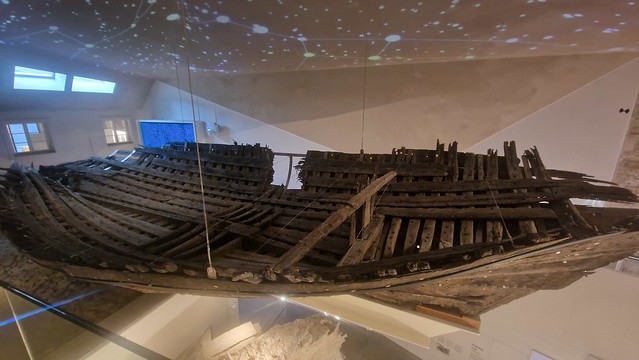Tallinn Trip – Fat Margaret Museum (Tallinn’s Time Capsule Boat)
Carrying on with my little series of posts about what I considered to be interesting things at the Fat Margaret Museum.
What is evidently a rather fascinating discovery provided something of a unique window into the city’s maritime past and it’s this old boat, which I accept is a little past its best. During construction work near the Old City Harbour, this 700-year-old cog, a type of merchant vessel prevalent during the Hanseatic League era, was unearthed. Dating back to the 1360s, the ship’s remarkable preservation offered new insights into medieval shipbuilding and trade.
Viewed from underneath, the cog, which is 24.5 metres long and 9 metres wide, was carefully excavated and is now on display at the museum. Its construction, using overlapping oak planks (a technique known as clinker building) sealed with animal hair and tar, is rather a testament to the craftsmanship of medieval shipbuilders given that it hasn’t fallen apart. The vessel’s flat bottom and single mast made it ideal for navigating the shallow waters and varied conditions of the Baltic Sea trade routes, which extended from the North Sea to Russia. I was going to see what Bev and Susanna thought about the arrangement, but they were around five rooms behind me reading every word they could find. Ross had already gone back to the hotel, worn out from museums.
This particular cog is particularly significant (I obviously didn’t know this, it’s written on the information board) because it may represent a previously undocumented Scandinavian design. While initially thought to be a transitional form between a cog and a hulk (apparently a larger vessel with two masts), further research suggests it may be unique to the region. The ship’s cargo hold contained a wealth of artefacts, including everyday items like leather shoes and wooden spoons, as well as tools and even the skeletal remains of two rats. They even discovered a functioning dry compass (https://en.wikipedia.org/wiki/History_of_the_compass#Dry_compass), the oldest of its kind found in Europe, highlighting the advanced navigational technology of the time. The Tallinn cog is now something of a highlight of the museum’s collections and it’s not the most subtle of little things, being the first thing visitors see when they enter.







